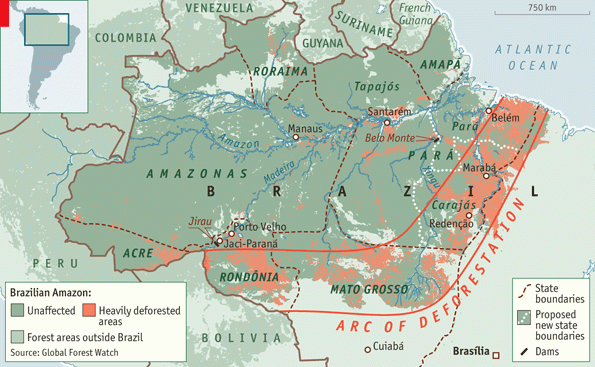An Overview of REDD: Its History and Current State

Governments around the world will have pledged more than $7 billion to support “REDD”, which is an acronym for “Reduced Emissions from Deforestation and Degradation” of forests. The acronym covers a broad set of activities that aim to slow climate change by saving endangered forests and keeping carbon locked in trees.
Do you find REDD confusing, opaque, and obtuse? Do you wonder where it came from, and how it impacts indigenous people? Ecosystem Marketplace recently completed a series of articles on “Indigenous REDD”, which begins with the very first project in 1988 and concludes with an overview of the current jurisdictional proposals and how they dovetail with emerging efforts to get deforestation out of supply chains. These stories are designed to bring you far enough into the weeds to understand the issues, but not so far that you get in over your head. On this weADAPT page you will be able to read more information about them, along with links to the original articles.
REDD Dawn: The Birth of Forest Carbon
The first article in the series, called “REDD Dawn: The Birth of Forest Carbon” looks back at the world’s first REDD project, which was conceived in 1988 by the World Resources Institute. It offers a brief introduction to the science of carbon accounting and an overview of REDD within the climate talks.
Indigenous People Explore Many Shades of REDD
Indigenous people – and forest people in general – have long been among the planet’s most responsible stewards of the land. They’ve contributed the least to the global climate crisis, yet will suffer the most from its effects. REDD offers a way to rectify this injustice – and here’s how some indigenous leaders hope to make it work.
The article “Indigenous People Explore Many Shades of REDD” looks at how REDD has evolved on indigenous territories to-date, and how indigenous leaders believe it must change to truly deliver on its potential.
Chocó-Darién: What Projects Can – and Cannot – Achieve
Colombia’s civil war had the perverse effect of protecting the forests in and around the Tolo River, but peace brought loggers and cattlemen, while poverty drove desperate forest people to begin chopping trees. The Chocó-Darién: What Projects Can – and Cannot – Achieve article describes how they used REDD to fight deforestation and build the foundation for a more sustainable future. Furthermore, it offers a deep dive into a project developed by the Afro-Colombian Tolo River People – and a primer on how REDD plays out on the ground.
Indigenous Life Plans and Carbon Finance: Two Sides of the Same Coin?
In the early 1990s, environmentalists started experimenting with carbon finance to support conservation just as indigenous people of the Amazon began developing “Life Plans” to revive and support their traditions. A quarter century on, these two parall

el initiatives have evolved in ways that are surprisingly complimentary – so much so they’re starting to converge, and in surprising ways. Indigenous Life Plans and Carbon Finance: Two Sides of the Same Coin? examines the symbiotic relationship between indigenous “Life Plans” and REDD.
The Surui Forest Carbon Project: Lifeline For A Life Plan
Brazil’s Paiter-Surui and cosmetics giant Natura made history last month when Natura bought the first-ever indigenous REDD carbon offsets from this once-isolated people. That transaction capped six years of development on the part of the Surui, but the events that led to it have been brewing for decades. This article “The Surui Forest Carbon Project: Lifeline For A Life Plan”offers a detailed glimpse inside a pioneering indigenous project built on an indigenous Life Plan and show’s how persistence, persuasion, and positive thinking paid off for Chief Almir Narayamoga Surui and the planet. Initially posted in 2013, it’s a bit dated, but still a good read.
Jurisdictional REDD: Long Deferred, Soon Delivered
Forest-carbon projects are now conserving as much forested land as you’ll find in all of Malaysia. It’s a stunning achievement, but one that needs to get big fast if we’re to make a dent in global greenhouse gas emissions. Fortunately, jurisdictions like the Brazilian state of Acre are developing “jurisdictional REDD” programs to do just that. The article “Jurisdictional REDD: Long Deferred, Soon Delivered” examines the state of “jurisdictional” REDD programs – government-to-government programs that are designed to reduce deforestation across an entire state or country.
REDD+ And Green Supply Chains: The Yin And Yang Of Saving Forests
Companies worth more than $4 trillion have promised to reduce their impact on the world’s forests, and more than one-third of the new pledges came in 2014, which more than doubled 2013’s total. Now comes the hard part: keeping those promises honest, and helping smaller suppliers adjust to the new demand. Here’s how public finance for forest protection can help.
REDD+ And Green Supply Chains: The Yin And Yang Of Saving Forests examines role that REDD finance can play in helping to purge deforestation from corporate supply-chains.
(0) Comments
There is no content